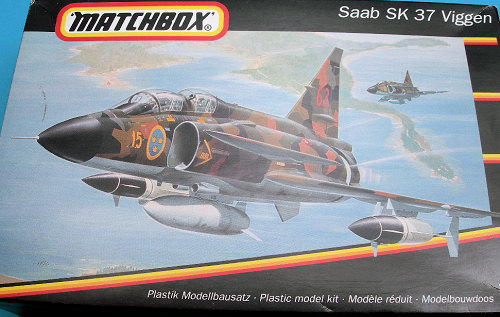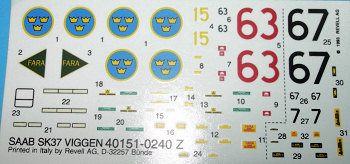
Matchbox 1/72 Saab SK 37 Viggen
| KIT: | Matchbox 1/72 Saab SK 37 Viggen |
| KIT #: | PK-131 (1988) |
| PRICE: | OOP |
| DECALS: | Two options |
| REVIEWER: | Victor Scheuerman |
| NOTES: | This kit is the 1997 Revell AG boxing (40151) |

| HISTORY |
The development of the Saab 37 was initiated to provide the Swedish air force with a fully integrated weapons system, based on the concept that had proved itself in the USA. Extensive tests led to the adoption for the fighter-interceptor of an unusual canard wing configuration for the flying components of the weapons system. There were large rear mounted delta wings with forward delta wings with flaps. This configuration accompanied an improved STOL capacity, so that the Saab 37 could be used on short runways about 500 m long. This aerodynamic design, together with the powerful turbofan engine with reverse thrust and anti-skid system considerably reduced the landing run. The pilot sits in a fully air conditioned pressure controlled cockpit behind a bird-strike proof windscreen. The high combat effectiveness of the plane was achieved by incorporating the latest avionics systems, such as a head-up display linked to a flight data computer and a digital fire control package for electronic counter-measures and a radar warning system. The aircraft were delivered to Flygflottilj 7 in Satenas on 21st June 1971. (Thanks to the kit instruction sheet.)
| THE KIT |
 As
this is a Revell boxing of what was originally a Matchbox kit (Revell purchased
the model line in 1990), its 69 parts are cleanly molded in one colour; green. A
clear two-piece canopy rounds out the molded parts. The single-seat Viggen was
released in 1977 and the date stamp on the interior fuselage of this two-seat
kit gives this date.
As
this is a Revell boxing of what was originally a Matchbox kit (Revell purchased
the model line in 1990), its 69 parts are cleanly molded in one colour; green. A
clear two-piece canopy rounds out the molded parts. The single-seat Viggen was
released in 1977 and the date stamp on the interior fuselage of this two-seat
kit gives this date.
Matchbox supplied their usual basic cockpit that in this case consists of only two ejection seat but these do resemble the unique Swedish seats used. There are two instrument coamings and both have flat instrument panels with no details. Externally, this kit is entirely engraved and while the panel lines are not quite to their infamous trench depth, some sanding and rattle can primer is still be recommended.
All the gear bays are framed in and the nose bay while still too shallow is deeper then most. Matchbox did a credible job on the landing gear that is rather robust and busy. Each main gear consists of four parts and it is nice to see both the retraction arms and sway braces. All tires have nice wheel detail. While the gear doors are too thick, the main ones should be sanded thinner in lieu of replacing with card as the small exterior blister is replicated. Overall, one of their better landing gears.
Other external details that should be mentioned are those large and nasty looking Rb 04 medium-range anti-shipping missiles, center line drop tank, the unique afterburner configuration is captured, and four outlets for the fuselage are supplied as separate parts. However, there are two details included with the kit that I could only find on photographs of the prototype. These are what appear to be two IR housings (?) mounted on the lower forward fuselage and the ECM pod that is mounted separate on the outboard wing station.
 The
kit wings are the correct production version and the only outline issue I noted
was the trailing edge of the canards are raked too much. One of the best
reference for this aircraft is World Air Power Journal Volume 13 and on
page 79 there is a full colour three-view that is 1/72 scale or very close.
The
kit wings are the correct production version and the only outline issue I noted
was the trailing edge of the canards are raked too much. One of the best
reference for this aircraft is World Air Power Journal Volume 13 and on
page 79 there is a full colour three-view that is 1/72 scale or very close.
As this is a Revell issue of the kit, the instructions reflect this as the assembly, paint schemes and history are on three separate sheets. Assembly and detailed colour notes are fully covered in 15 steps and the sprue layout is also included. Two marking options are offered and these are fully shown in two excellent four-views of each aircraft. The scheme selection is excellent as both a medium grey over light grey and the complicated Swedish splinter schemes are offered. The decals as expected look excellent and these include both the multi-coloured stenciling and night formation light strips.
| CONCLUSIONS |
This is actually a very nice kit. It appears to be accurate, fully engraved, offers an interesting and unique external load, has both a basic and difficult camouflage finish and kit decals that can be used. With some card detail added to the cockpit and using a supply of Tamiya tape to mask the splinter camouflage pattern, a rather nasty looking two-seat ship-killer is in the offering.
October 2007
If you would like your product reviewed fairly and quickly, please contact me or see other details in the Note to Contributors.